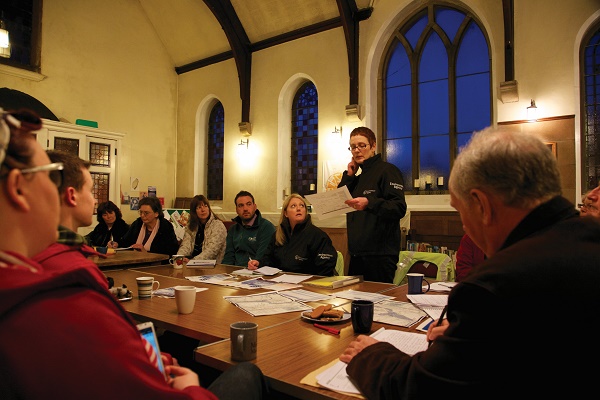Why is it important?
Local adaptation plans currently lack sufficient consideration of social justice issues1.

Environment Agency staff speaking at a public flood and coastal risk management (FCRM) meeting at Irwell Community Hall in 2013. © Environment Agency
On this page
Engaging local communitities
This could be improved by increasing connections with partners and networks where social justice is a core consideration, such as organisations directly working with vulnerable communities2.
Despite processes of public consultation, plans and policies associated with climate change often tend to attract comment from other organisations3 and do not engage local communities. Furthermore, public participation rates are falling. The Citizenship Survey 2009-10 showed that the proportion of people engaging in consultation about local services and related activities fell from 21% in 2007-8 to 18% in 2009-10.
Some social groups are disproportionately represented among participants, giving them a stronger influence over what happens both nationally and in their local community. People from vulnerable groups tend not to be represented, despite being the groups that many actions are designed to help.
Participation rates have a strong geographical dimension. Figure 1 shows the number of voluntary organisations per thousand people within local authority areas in England. If this is taken as a proxy for community engagement, the data suggest that some places, such as urban areas, are likely to have low engagement, this also limits the development of social networks which derive from participating in volunteering activities.

Figure 1: Number of voluntary organisations per thousand people in English local authorities4
Participation is an important determinant of the legitimacy and effectiveness of actions taken. If the views of people within a target vulnerable group have not been taken into account through a process of active engagement, then the activities aimed at reducing the vulnerability of that group may not be effective once implemented. As a result it has been suggested that inequalities in participation in decision-making about community resources cannot be separated from inequalities in the outcomes of such decisions5.
Duties and responsibilities
Local authorities and their partners in health and social care have statutory duties and other responsibilities to engage communities (see the presentation Why Climate Justice matters). For example:
- The Health and Social Care Act (2012) stresses the goal of empowering the users of health and social care services through Healthwatch England and associated local Healthwatch bodies. Local Healthwatch organisations aim ‘to give citizens and communities a stronger voice to influence and challenge how health and social care services are provided within their locality’. Joint Strategic Needs Assessments (JSNAs) and the associated strategies produced by Health and Wellbeing Boards have a duty to involve people living and working in local communities6, to consider how to address the needs of vulnerable groups, including in the context of climate change, as a driver of health and wellbeing, and also in terms of providing accessible information. Guidance recognises that some groups may be hard to engage but stresses that a lack of engagement could indicate unmet needs and encourages the use of local Healthwatch bodies as a means of direct local engagement with groups that are ‘seldom heard’, vulnerable or socially excluded7.
- The National Planning Policy Framework 2012 (NPPF) requires local planning authorities to take the wishes of local communities into account as part of a proactive approach to both climate adaptation and mitigation.
- The Localism Act (2011) introduced a set of new rights and powers for local communities. These include the right to draw up a Neighbourhood Plan and the ‘right to challenge’ and take over public services, for example through the use of voluntary and community groups. The Act also provides additional specific rights for social tenants with respect to the services offered by social landlords.
- The Equality Act 2010 allows for positive action in favour of people in groups with protected characteristics8, including age and disability.
See the Why climate justice matters presentation for a summary of relevant legislation. Scottish and Welsh versions are also provided reflecting the different legislative context in each case.
References
- Brisley, R., Welstead, J., Hindle, R. and Paavola, J. (2012) Socially just adaptation to climate change. York: Joseph Rowntree Foundation
- Preston, I. et al (2014) Climate Change and Social Justice: An Evidence Review, JRF
- Preston, I. et al (2014) Climate Change and Social Justice: An Evidence Review, JRF
- Participation, trends, facts and figures (2011) National Council for Voluntary Organisations (NCVO)
- Bulkeley, H., Edwards, G. and Fuller, S. (2012) ‘Towards Climate Justice in the City? Examining the Politics, Practice and Implications of Urban Climate Responses in Global Cities’, paper given to the Sixth Urban Research and Knowledge Symposium, Barcelona, 8–10 October 2012 cited in Preston, I. et al 2014 Climate Change and Social Justice: An Evidence Review, JRF
- Summary table of the duties and powers introduced by the Health and Social Care Act 2012 Department of Health
- Statutory Guidance on Joint Strategic Needs Assessments and Joint Health and Wellbeing Strategies March 2013 Department of Health
- GOV.UK website Discrimination, your rights

Built by:

© 2014 - Climate Just
Contact us
